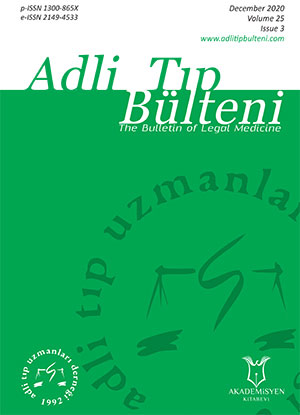The Components to Be Considered In The Evaluation of Disability Rate Related to Traffic Accident In The Light of The Supreme Court's Decisions
DOI:
https://doi.org/10.17986/blm.1369Keywords:
Supreme court, decision of reversal, ground, disability report, traffic accidentAbstract
Objective: Traffic accidents can cause liability in terms of both criminal and compensation law. Forensic specialists have a great role in the assessment of permanent sequelae and disability rates associated with these sequelae. In this study, we aimed to evaluate the issues to be taken into consideration by examining the Supreme Court’s decisions of reversals about disability reports related to traffic accidents.
Materials and Methods: The decisions were searched in https://karararama.yargitay.gov.tr/YargitayBilgiBankasiIstemciWeb/ by using the concepts of legal regulations which are used in the evaluation of disability rate and “traffic accident” as keywords. The Supreme Court of Decisions of Reversals for disrupting the Decisions about the disability rate reports related to traffic accidents taken by the first-instance courts were researched.
Results: 376 Decisions of Reversal of 17th Supreme Court were reached. The issuance of reports according to the statute/regulation which was not in effect at the date of the unjust act was the most frequent (n=262, 69.7%) ground. Then, contradictory rates among the received reports, uncertainty/impenetrability about which statute/regulation is based in the report, spelling errors, not taken a disability report for the basis of the provision and the problems related to the causal link were determined respectively.
Conclusion: Disability reports should be understandable, reasoned and in accordance with the relevant legislation. Reports that are not prepared in accordance with the legislation in force, not justified properly, have the problems about causality, conflicting and unsuitable for inspection may cause loss of rights, prolongation of the trial process.
Downloads
References
Hilal A. Maluliyet Hesaplamalarında Karşılaşılan Sorunlar. Bull Leg Med [Internet]. 18 Ağustos 2016 [a.yer 15 Aralık 2019];21(2). https://doi.org/10.17986/blm.2016220387 DOI: https://doi.org/10.17986/blm.2016220387
Eşiyok B, Korkusuz İ. Yaşlılarda Travmaya Bağlı Maluliyet. Turkish Journal of Geriatrics, 2006;9(4):213-217.
Pfortmueller CA, Marti M, Kunz M, Lindner G, Exadaktylos AK. Injury Severity and Mortality of Adult Zebra Crosswalk and Non- Zebra Crosswalk Road Crossing Accidents: A Cross-Sectional Analysis. Plos One. 2014;9(3):1-6. https://doi.org/10.1371/journal.pone.0090835 DOI: https://doi.org/10.1371/journal.pone.0090835
TUİK, Trafik Kaza İstatistikleri, Yıllara göre kaza, ölü ve yaralı sayısı. http://www.tuik.gov.tr/PreTablo.do?alt_id=1051, Erişim tarihi: 09.12.2019.
Hekimoğlu Y, Gümüş O, Kartal E, Etli Y, Demir U, Aşirdizer M. Maluliyet Oranlarının Yaş ve Cinsiyet ile İlişkisinin Değerlendirilmesi, Van Tıp Derg 2017;24(3): 173-181, 2017 https://doi.org/10.5505/vtd.2017.53244 DOI: https://doi.org/10.5505/vtd.2017.53244
Hilal A. Trafik Kazalarında Maluliyet. Dülger HE, editör. Trafik Kazalarında Maluliyet. 1. Baskı. Ankara: Türkiye Klinikleri; 2019. p.19-23.
Kaya A, Meral O, Erdoğan N, Aktaş EÖ. Maluliyet Raporlarının Düzenlenmesi: Anabilim Dalımıza Başvuran Olgu Özellikleri İle. Adli Tıp Bülteni, 2015;20(3):144-151. https://doi.org/10.17986/blm.2015314259 DOI: https://doi.org/10.17986/blm.2015314259
Ata U. EÜTF Adli Tıp Anabilim Dalında Düzenlenen Meslekte Kazanma Gücündeki Azalma Oranı Raporlarının Engelli Sağlık Kurulu Raporları ile Karşılaştırılması. [Uzmanlık Tezi] Ege Üniversitesi Tıp Fakültesi Adli Tıp Anabilim Dalı. İzmir, 2019. 89 s.
Aktaş EÖ, Kaya A, Çelik C. Ceza ve hukuk muhakemeleri açısından değerlendirme ve raporlama işlemlerinde zaman. Balcı Y, editör. Adli Tıpta Zaman. 1. Baskı. Ankara: Türkiye Klinikleri; 2019. p.24-31.
Downloads
Published
Issue
Section
License
Copyright (c) 2020 The Bulletin of Legal Medicine

This work is licensed under a Creative Commons Attribution 4.0 International License.
The Journal and content of this website is licensed under the terms of the Creative Commons Attribution (CC BY) License. The Creative Commons Attribution License (CC BY) allows users to copy, distribute and transmit an article, adapt the article and make commercial use of the article. The CC BY license permits commercial and non-commercial re-use of an open access article, as long as the author is properly attributed.

